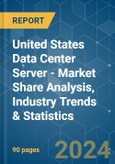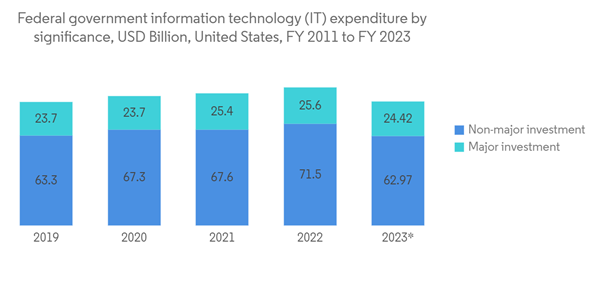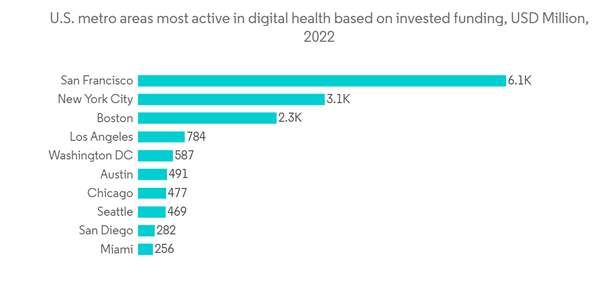The United States data center server market attained a value of USD 24.5 billion in the previous year, and it is further projected to register a CAGR of 8.5% during the forecast period. The increasing demand for cloud computing among (small and medium-sized enterprises)SMEs, government regulations for local data security, and growing investment by domestic players are some of the major factors driving the demand for data centers in the country.
Under Construction IT Load Capacity: The upcoming IT load capacity of the United States data center rack market is expected to reach 24,000 MW by 2029.
Under Construction Raised Floor Space: The country's construction of raised floor area is expected to increase to 80 million sq. ft by 2029.
Planned Racks: The country's total number of racks to be installed is expected to reach 4,035,000 units by 2029. Northern Virginia is expected to house the maximum number of racks by 2029.
Planned Submarine Cables: There are more than 80 submarine cable systems connecting the United States, and many are under construction.
In August 2023, Dell, Intel, and VMware offered an updated ReadyNode infrastructure solution called vSAN 8.0 with Express Storage Architecture (ESA). This release includes performance and efficiency improvements to meet customers' evolving data center needs.
In August 2023, Hewlett Packard Enterprise announced that global IT services provider phoenixNAP is expanding its bare metal cloud platform with cloud-native HPE ProLiant RL300 Gen11 servers powered by energy-efficient processors from Ampere Computing.
This product will be delivered within 2 business days.
Under Construction IT Load Capacity: The upcoming IT load capacity of the United States data center rack market is expected to reach 24,000 MW by 2029.
Under Construction Raised Floor Space: The country's construction of raised floor area is expected to increase to 80 million sq. ft by 2029.
Planned Racks: The country's total number of racks to be installed is expected to reach 4,035,000 units by 2029. Northern Virginia is expected to house the maximum number of racks by 2029.
Planned Submarine Cables: There are more than 80 submarine cable systems connecting the United States, and many are under construction.
United States Data Center Server Market Trends
IT & Telecommunication Is The Largest Market In The Country
- The COVID-19 pandemic impacted the economic impact of early entrants on digital transformation by offering digital products and services or by using digital processes more than their competitors engaged in digital transformation.
- Of the US corporate infrastructure decision-makers, 94% have at least one cloud deployment, with hybrid or multi-cloud solutions more common. Nearly 74% of US infrastructure decision-makers say their organizations are adopting containers as a platform as a service (PaaS) in on-premises or public cloud environments. Clouds are expected to increase significantly.
- US cloud providers include AWS, Microsoft, and Google. Among enterprise infrastructure decision-makers, 94% use at least one type of cloud deployment, with the majority being hybrid or multi-cloud.
- In the United States, cloud storage is growing due to the growing demand for cost-effective data backup, storage, and backup in every business and the need to manage the data generated by the increasing use of mobile phones.
- With the rise of the digital economy and increased Internet usage in the United States, the need for data storage and processing has increased. The proliferation of hybrid cloud service providers has increased demand for colocation services and increased rack utilization.
Blade Servers To Grow At A Faster Pace In The Coming Years
- Blade servers are often used for huge processing data, but they also produce a lot of heat. These tend to be more expensive than rack or tower servers and require proper humidity and cooling infrastructure to run efficiently without damaging the hardware.
- Blade servers are installed in server bays, not in racks. This structure allows more servers to be installed in a smaller area. For example, a rack may only hold 10 rack servers, but a blade bay can hold 20 blade servers. The blade chassis can still be rack mounted, but more blade servers can fit in the same space compared to rack servers.
- In August 2023, Mercury Systems, Inc., a United States-based company that delivers computing power for the most demanding aerospace and defense missions, announced Common Module System (CMS) X08, the industry's first robust open standards-based blade server architecture. This is a play-and-play infrastructure model for tactical platforms that operate on sea, land, and air.
- To cater to end-user needs, the top companies are focusing on blade servers in data centers. The growing adoption of technologies such as cloud computing, artificial intelligence (AI), and IT services by businesses is propelling the use of servers in data centers.
- In the coming future, the evolution of healthcare will focus on the reengineering of clinical care and operations around digital health and the pervasive, real-time use of data and advanced analytics to achieve these goals. Such achievements would require a large amount of data to be stored, which would drive the need for data center blade servers over the forecast period.
United States Data Center Server Industry Overview
The United States data center server market is moderately competitive and has gained a competitive edge in recent years. In terms of market share, a few major players, such as Dell Inc., International Business Machines (IBM) Corporation, Hewlett Packard Enterprise (HPE), Lenovo Group Limited, and Cisco Systems Inc., currently dominate the market.In August 2023, Dell, Intel, and VMware offered an updated ReadyNode infrastructure solution called vSAN 8.0 with Express Storage Architecture (ESA). This release includes performance and efficiency improvements to meet customers' evolving data center needs.
In August 2023, Hewlett Packard Enterprise announced that global IT services provider phoenixNAP is expanding its bare metal cloud platform with cloud-native HPE ProLiant RL300 Gen11 servers powered by energy-efficient processors from Ampere Computing.
Additional Benefits:
- The market estimate (ME) sheet in Excel format
- 3 months of analyst support
This product will be delivered within 2 business days.
Table of Contents
1 INTRODUCTION
4 Market Dynamics
5 MARKET SEGMENTATION
6 COMPETITIVE LANDSCAPE
6.1.3 International Business Machines (IBM) Corporation
Methodology

LOADING...










